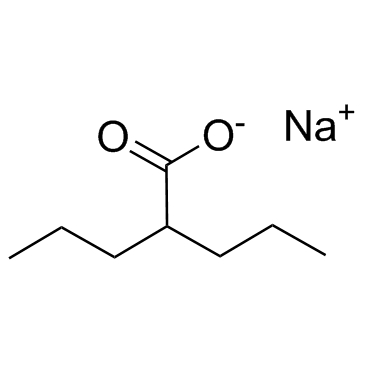Sodium 2-propylpentanoate

Sodium 2-propylpentanoate structure
|
Common Name | Sodium 2-propylpentanoate | ||
|---|---|---|---|---|
| CAS Number | 1069-66-5 | Molecular Weight | 166.193 | |
| Density | 1.0803 g/cm3 | Boiling Point | 220ºC at 760 mmHg | |
| Molecular Formula | C8H15NaO2 | Melting Point | 300 °C | |
| MSDS | Chinese USA | Flash Point | STABILITY | |
| Symbol |

GHS07 |
Signal Word | Warning | |
|
Stability of structured Kaposi's sarcoma-associated herpesvirus ORF57 protein is regulated by protein phosphorylation and homodimerization.
J. Virol. 89(6) , 3256-74, (2015) Kaposi's sarcoma-associated herpesvirus (KSHV) ORF57 plays an essential role in KSHV lytic infection by promoting viral gene expression at the posttranscriptional level. Using bioinformatic and biochemical approaches, we determined that ORF57 contains two str... |
|
|
Developing structure-activity relationships for the prediction of hepatotoxicity.
Chem. Res. Toxicol. 23 , 1215-22, (2010) Drug-induced liver injury is a major issue of concern and has led to the withdrawal of a significant number of marketed drugs. An understanding of structure-activity relationships (SARs) of chemicals can make a significant contribution to the identification o... |
|
|
A predictive ligand-based Bayesian model for human drug-induced liver injury.
Drug Metab. Dispos. 38 , 2302-8, (2010) Drug-induced liver injury (DILI) is one of the most important reasons for drug development failure at both preapproval and postapproval stages. There has been increased interest in developing predictive in vivo, in vitro, and in silico models to identify comp... |
|
|
Chemical genetics reveals a complex functional ground state of neural stem cells.
Nat. Chem. Biol. 3(5) , 268-273, (2007) The identification of self-renewing and multipotent neural stem cells (NSCs) in the mammalian brain holds promise for the treatment of neurological diseases and has yielded new insight into brain cancer. However, the complete repertoire of signaling pathways ... |
|
|
Evaluation of a published in silico model and construction of a novel Bayesian model for predicting phospholipidosis inducing potential.
J. Chem. Inf. Model. 47 , 1196-205, (2007) The identification of phospholipidosis (PPL) during preclinical testing in animals is a recognized problem in the pharmaceutical industry. Depending on the intended indication and dosing regimen, PPL can delay or stop development of a compound in the drug dis... |
|
|
Neural computational prediction of oral drug absorption based on CODES 2D descriptors.
Eur. J. Med. Chem. 45 , 930-40, (2010) A neural model based on a numerical molecular representation using CODES program to predict oral absorption of any structure is described. This model predicts both high and low-absorbed compounds with a global accuracy level of 74%. CODES/ANN methodology show... |
|
|
Multi-target spectral moment QSAR versus ANN for antiparasitic drugs against different parasite species.
Bioorg. Med. Chem. 18 , 2225-31, (2010) There are many of pathogen parasite species with different susceptibility profile to antiparasitic drugs. Unfortunately, almost QSAR models predict the biological activity of drugs against only one parasite species. Consequently, predicting the probability wi... |
|
|
DJ-1 regulates the expression of renal (pro)renin receptor via reactive oxygen species-mediated epigenetic modification.
Biochim. Biophys. Acta 1850(2) , 426-34, (2015) DJ-1 protein plays multifunctional roles including transcriptional regulation and scavenging oxidative stress; thus, it may be associated with the development of renal disorders. We investigated whether DJ-1 protein regulates the expression of (pro)renin rece... |
|
|
Species-dependent binding of tocainide analogues to albumin: affinity chromatography and circular dichroism study.
J. Chromatogr. B. Analyt. Technol. Biomed. Life Sci. 968 , 69-78, (2014) A series of novel tocainide analogues were characterized for their HSA and RSA binding, by using high-performance liquid affinity chromatography (HPLAC) and circular dichroism (CD). In this HPLAC study, HSA and RSA were covalently immobilized to the silica ma... |
|
|
An effective assessment of valproate sodium-induced hepatotoxicity with UPLC-MS and (1)HNMR-based metabonomics approach.
J. Chromatogr. B. Analyt. Technol. Biomed. Life Sci. 969 , 109-16, (2014) Valproate sodium is one of the most prescribed antiepileptic drugs. However, valproate sodium has various side effects, especially its toxicity on liver. Current markers for toxicity reflect mostly the late stages of tissue damage; thus, more efficient method... |